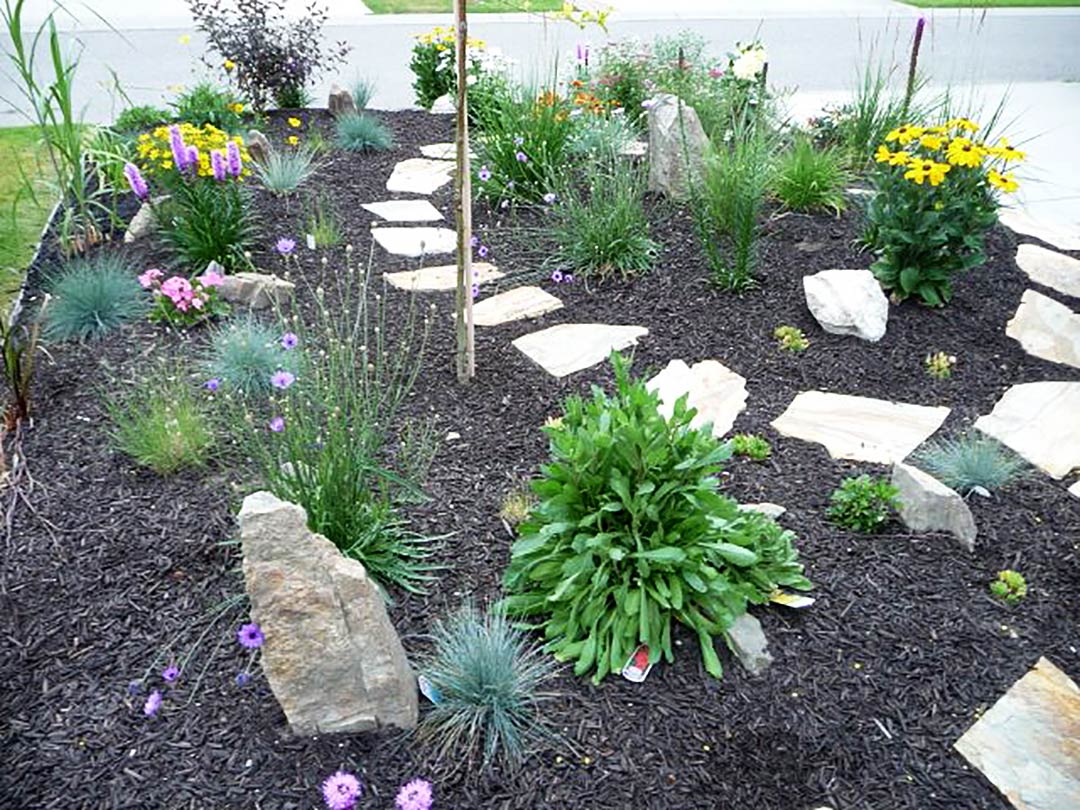Planting & Maintenance Guidelines
CARE IN NURSERY POTS
- If you won’t be able to plant them as soon as you buy them, your plants should be put in a shaded area and watered frequently (check them daily). In hot or windy weather, potted plants dry out very quickly and may need watering up to twice a day.
- If a plant does dry out, submerge the pot completely in a bucket of water and hold it down until the bubbles stop coming out. If the plant does not recover in a few hours, trim back some of thefoliage.

PLANTING
- Be sure to space plants for mature size to avoid crowding and extra maintenance chores in future.
- Submerge each pot in a bucket of water until the bubbles stop coming out to be sure the root ball is soaked. If it is dry when you plant, the roots may stay dry no matter how much you water the surrounding ground. Then your plant could die from lack of water.
- Pull the plant gently out of its pot. If it resists, tap the side of the pot or squeeze it to release the plant. If necessary, cut the pot.
- Dig a hole about twice the width of the pot and one and a half times deeper than the pot depth.
- Add some bone meal to the soil at the bottom of the hole to encourage root growth, and mix it in to a depth of two or three inches. This is optional. See package directions.
- Fill the hole with water. Wait until the water has drained away.
- If there are a lot of roots on the outside of the root ball, gently loosen the roots, especially at the bottom. If you don’t do this, the plant will think it’s still in a pot and the roots will not spread out into the surrounding soil. It will fail to thrive and could eventually die. If roots are very dense, make a few shallow vertical cuts through the side of the root ball and across the bottom to encourage the roots to grow out into the soil.
- Place the plant in the hole, making sure that the top of the root ball is slightly lower than the top of the hole so you can be sure to lightly cover the roots with soil.
- Fill in the hole, either with the original soil, or a 1:3 mixture of compost and soil. Press the soil down firmly with your hand around the plant stem. The plant should now be in a slight depression. This will allow water to soak down onto the roots rather than running off.
- Thoroughly soak the plant again. If the weather is warm, or you are on a slope, you may want to build a “dyke” of soil in a circle around the edge of the hole. This will ensure that water will soak into the root area of the plant when you are watering and when it rains.
- Spread mulch over the soil to retain moisture and suppress weeds.
- If bedding plants or perennials are leggy (tall and spindly) when planted, it’s a good practice to cut them back a bit so the roots have a good chance to get established without struggling to maintain a lot of foliage. This will give you a much bushier, healthier plant more quickly. For trees and shrubs, prune off some top growth to begin to shape the plant and to allow roots to get established.
WATERING
- Until your plants’ roots have grown into the surrounding soil, they need regular watering. Even drought tolerant plants need at least a year with some watering to fully establish themselves. For trees and shrubs this will take longer.
- It is better to water less frequently for a longer time to allow water to soak down into the soil.
This encourages plants to grow deep healthy roots which are less susceptible to drought. - If a plant looks unhappy, check the soil before watering. Too much water will cause roots to rot!
- Unless you have heavy clay soil, or know that your plants don’t like winter moisture, make sure that the soil is quite wet in the fall. Our cold weather with low snowfall causes many plants to be killed by dehydration over the winter. Be particularly careful in areas such as under the eaves of your house where you don’t get natural precipitation.
MULCHING
- The best thing that you can do to ensure the health of your plants is to mulch them immediately after planting.
- A one to three inch layer of compost, well rotted manure, Ogogrow, or other similar material
keeps the soil moist, discourages weed seeds from germinating, and if they do, the weeds are
much easier to pull out. - Soil must be moist and weed free before applying mulch.
- Mulch prevents a hard crust from forming on the soil surface after rain fall or watering and keeps the soil warm over the winter and cool during hot weather.
- Replenish the mulch every year or so. As it decomposes, it provides the organic matter needed for healthy soil and slowly releases all the nutrients/fertilizer needed to keep your plants healthy.

GENERAL CARE
- Many summer blooming perennials and annuals continue to bloom if the dead flowers are cut off regularly.
- Remove damaged or dying foliage. This encourages the plant to grow healthy new leaves.
- To reduce costs and maintenance time, consider replacing plants that attract pests and diseases with ones that thrive in our climate. There are hundreds of varieties to choose from.
Print out our
Planting Guidelines PDF
for your convenience
